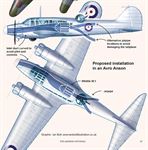Фотографии
-
Two Gloster E.28/39s were built, W4041 and W4046, the second making its first flight on March 1, 1943. Both were extensively tested by RAE and Service pilots at Farnborough, where this photograph shows an E.28/39 being put through its paces. Had an Anson been fitted with a W.1, it would have required the incorporation of a similar nose intake.
Самолёты на фотографии: Gloster Pioneer / G.40 - Великобритания - 1941
-
INSTALLING THE WHITTLE W.1 JET ENGINE in the Gloster E.28/39
Самолёты на фотографии: Gloster Pioneer / G.40 - Великобритания - 1941
-
Регистрационный номер: K6152 Known affectionately by its crews as “Faithful Annie”, the Avro Anson entered RAF service in March 1936 as a general reconnaissance aircraft for Coastal Command. This Anson I, K6152, was delivered to the RAE at Farnborough from the manufacturer, so may have been a candidate for the fitting of the Whittle test unit in 1939.
Самолёты на фотографии: Avro Anson / Type 652 - Великобритания - 1935
-
Самолёты на фотографии: Avro Anson / Type 652 - Великобритания - 1935
-
INSTALLING THE WHITTLE W.1 JET ENGINE. Proposed installation in an Avro Anson
Самолёты на фотографии: Avro Anson / Type 652 - Великобритания - 1935
-
Регистрационный номер: G-AGBN One of the aircraft considered for the fitting of a Whittle jet powerplant was the General Aircraft Ltd Cygnet II two-seat light tourer, powered by a 150 h.p. Blackburn Cirrus Major and fitted with an unusual tricycle undercarriage. This example, G-AGBN, was impressed into RAF service in July 1941 and given the serial ES915.
Самолёты на фотографии: General Aircraft Cygnet II / GAL.42 - Великобритания - 1939
-
Регистрационный номер: R2676 Stearman-Hammond Y-1 PH-APY had been acquired by KLM as a tricycle undercarriage trainer for its prospective fleet of Douglas DC-5s, but was sold to the British Air Ministry and used by the RAE from the summer of 1939 with the military serial R2676. Fitting the Whittle W.1 unit would have presented something of a challenge!
Самолёты на фотографии: Stearman-Hammond Y-1 - США - 1936
-
Miles Aircraft’s first venture into twin-engined aircraft (and its first to have a retractable undercarriage), the M.8 Peregrine made its first flight on September 12, 1936. After a great deal of demonstration flying, it was dismantled in 1937, as Miles’s capacity was taken up with building Magisters for the RAF. Only two M.8s were built.
Самолёты на фотографии: Miles Peregrine / M.8 - Великобритания - 1936
Статьи
- -
- A.Delalande, T.Cooper - An eye for an eye
- C.Goss - Last days of the Condor
- E.Wild - Hijack hijinks!
- G.Baughen - A Brief History of the Future
- J.Forsgren - The flying darkroom
- J.Matos - Nao obrigado!
- M.Bearman - The Whirlwind becalmed
- M.Wickstead - A sky full of frontiers
- M.Willis - How to build a Sea Hawk
- N.Stroud - Fire in the belly
- N.Stroud - Heathrow. The Roaring Forties /The John Stroud Archive/
- P.Davidson - Off the Beaten Track...
- P.Jarrett - Lost & Found
- P.Jarrett - The Blue Falcon
- R.Riding - Three deadly minutes







